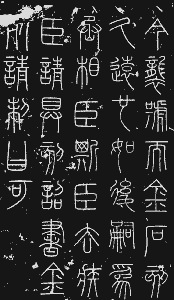With a time-honored history,Chinese calligraphyfalls into five schools:sealscript,official script,regular script, running script and cursive script, each having its own characteristics and aesthetic beauty.
 Seal Script
Seal Script
Greater Seal Script
 |
|
ZhuanshuCalligraphy by Li Si
|
Zhouwen is also called
Dazhuan(greater seal script). Shuo Wen Jie Zi (Elucidations of the Signs and Explications of the Graphs), compiled by Xu Shen, included more than 220 Zhouwen characters. Modern scholar Wang Guowei thought that these characters featured balanced left and right parts and a bit complicated structures.
Shiguwen is the representative of Dazhuan. During the Sui (581-618) and Tang (618-907) dynasties, ten stone tablets were found in Tianxing County (present-day Fengxiang County inShaanxi Province). Textual researches show that these stone tablets were from the late years of theSpring and Autumn Period(770-476BC) and the early years of theWarring States Period(475-221BC). Shiguwen on these tablets were all poems paying tributes to Emperor Qinshihuang.
Three stones carved with inscriptions were discovered in theNorthern Song Dynasty(960-1127), and contents were all malediction from the King of the Qin State to the King of the Chu State. People in the later generations called these inscriptions as Zhouchuwen (Script of Malediction to Chu). Zhouwen, Shiguwen, Zhouchuwen and part of inscriptions onbronzein the Qin State all belonged to the same style and are collectively called as Zhouwen or Dazhuan. Zhouwen, characterized by shapely strokes and compact structures, was officially prescribed standard script of that time and had been used for a long period.
Lesser Seal Script
Xiaozhuan(lesser seal script), also called Qinzhuan, is acalligraphydeveloped from Dazhuan (greater seal script). It emerged in the Qin State in the late Warring States Period (475-221BC), and was prevalent in theQin Dynasty(221-206BC) and earlyWestern Han Dynasty(206BC-8AD).
Cultural relics of the Qin Dynasty unearthed show that Xiaozhuan was an evolvement from Dazhuan, and there is no distinct demarcation in time between the two. Some characters of Dazhuan were comparatively complicated and difficult to write, but became more simplified starting from the Spring and Autumn Period (770-476BC), when the process of simplification obviously picked up. Persons like Li Si, the Minister of Qinshihuang, collected and arranged the characters of Xiaozhuan, making it standard characters and popular in society.
